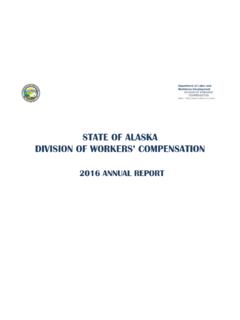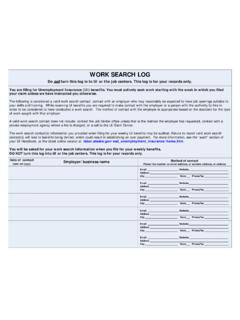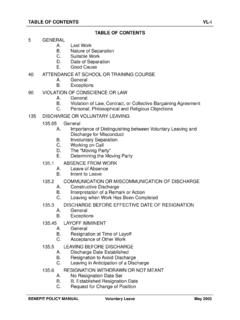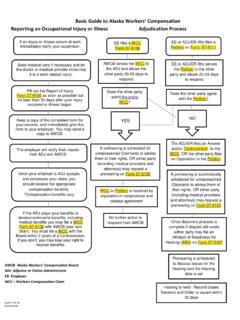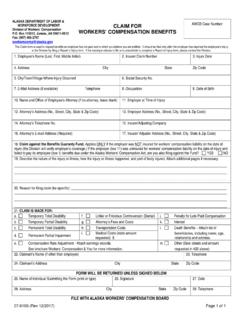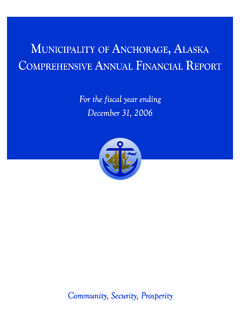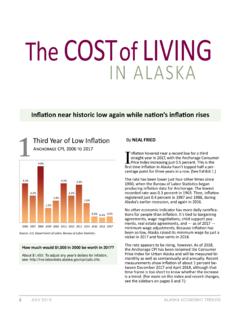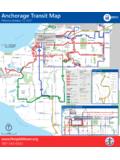Transcription of Table of Contents - Alaska Dept of Labor
1 Table of Contents Unemployment Insurance Tax i How did Employment Security get its start? .. 1 Unemployment Insurance Tax .. 1 Office 2 3 Who is an Employer? .. 4 Out-of-state and multi-state employers .. 4 Fishing and maritime employers .. 5 General Information .. 5 Establishing a tax account .. 5 Contribution Report, Form TQ01 .. 6 Taxable wage base .. 7 Employee s contribution .. 7 No wages to report for a quarter .. 7 Mid-quarter change .. 7 Estimated reports .. 8 Records required .. 8 Federal Unemployment Tax Act (FUTA).. 9 Excluded Employment .. 9 Election of coverage for excluded employment .. 12 Wages and Excluded Payments .. 12 Contract and Casual Labor .. 14 Contract Labor 14 What about casual Labor ? .. 16 Adjustments and Reporting 17 Common reporting problems and their 17 Retirement Plans, Section 125 Cafeteria Plans, and other Fringe Benefits.
2 18 Retirement Plans .. 19 Section 125 Cafeteria Plans .. 20 Fringe Benefits .. 20 Employer and Contractor Responsibilities .. 22 Employers and contractors can avoid liability .. 22 Tax clearances .. 22 Contribution Rates .. 23 Quarterly decline .. 24 Adjustments for artificially created quarterly declines .. 24 Successor in business .. 25 Responsibilities of successors .. 25 Nonprofit Organizations, Political Subdivisions and Federally Recognized Tribes .. 26 What is a Nonprofit Organization? .. 26 When does a Nonprofit become an employer? .. 26 What is a Political Subdivision? .. 27 What is a Federally Recognized Tribe? .. 27 Reimbursable Payment Method .. 27 The risks .. 28 Electing the reimbursable method .. 29 Bonding and security requirements .. 29 Terminating the reimbursable payment method .. 29 Employees contributions .. 30 Audits .. 30 Questions Concerning audits.
3 30 Interest and Penalties .. 32 Table of Contents Unemployment Insurance Tax ii Regular contributory employer .. 32 Reimbursable employers .. 33 Collections .. 33 Application of payments on delinquent balances .. 34 Compromise of contributions .. 34 Contractor liability .. 34 Executive officers, partners, members, and managers .. 34 Court action .. 34 Deferred payment contract .. 34 Distraint warrant .. 35 Employer s security for delinquent 35 Injunctive relief .. 35 Jeopardy Assessment .. 35 Lien .. 35 Lien release .. 36 Notice and Order to Withhold and Deliver .. 36 Notice of Assessment .. 36 Employer s response to a Notice of Assessment .. 36 Property disposal .. 36 Remedies are cumulative .. 37 Seizure of property .. 37 Statute of limitations.
4 37 Successor liability .. 37 Unemployment Insurance Tax Appeals .. 38 The appeals process .. 38 Types of tax 39 Hearing and pre-hearing conference notices .. 41 The pre-hearing conference .. 42 Preparing for the hearing .. 42 The hearing .. 43 The decision .. 45 Further appeal .. 45 This handbook was last updated April 2017 Unemployment Insurance Tax 1 Unemployment Insurance Tax and Unemployment Insurance How did Employment Security get its start? In October 1929, a plummeting stock market plunged America into a financial disaster that has been remembered ever since as The Great Depression. Left in its wake was an economic wasteland that offered no market for goods and no buying power. Industry closed its doors, businesses went broke, and hundreds of thousands of people were out of work, with little or no prospect for employment or income.
5 In response to the crisis, the government crafted a pair of laws to provide remedial and preventative action. The Wagner-Peyser Act signed into law in 1933, established employment offices throughout the country. The Alaska Employment Security Division is one of these offices. The Social Security Act, passed in 1935, established the laws that created Unemployment Insurance. This insurance is an efficient way to maintain economic stability, especially in areas where workers are laid off and employment is scarce. The Unemployment Insurance provisions of the Social Security Act were later replaced in 1939 by the Federal Unemployment Tax Act (FUTA), which incorporated the Social Security Act provisions into the Internal Revenue Code. Unemployment Insurance Tax The Unemployment Insurance (UI) Tax Section of the Alaska Employment Security Division (ESD) is located in the Alaska Department of Labor and Workforce Development (AKDOL).
6 It is primarily responsible for providing assistance and information to employers concerning the UI Tax program and for the collection of UI taxes. The basic activities of the UI Tax Section are to: Identify employers subject to UI laws, including: nonprofit organizations political subdivisions successor employers Assist and inform employers on how to: establish an account properly report wages determine when wages are excluded compute taxable wages Unemployment Insurance Tax 2 calculate contributions Educate employers about: multi-state employment fishing and maritime employment employer/employee relationships contract Labor issues Determine the tax rate for each contributory employer under the experience rating system, based on the quarterly payroll decline formula, and inform all employers of their tax rate.
7 Assist nonprofit employers, federally recognized tribes and political subdivisions in choosing between the contributory and reimbursable payment methods. Assist employers in lowering their quarterly decline by processing employer option forms for: lump-sum payments bonuses seventh bi-weekly payment of wages accounting anomalies Review all contribution reports, wage schedules and related documents submitted to identify potential problems and complete any necessary corrections. Complete field audits of employer records as required by federal guidelines. The audit also provides an opportunity for tax staff to meet and form working relationships with employers. Apply penalties and statutory tax collection remedies in order to enforce compliance with the law. Refund excess employer and employee contributions paid to UI Tax.
8 As required by law, UI Tax maintains a list of employee refunds and unclaimed employer refunds. Office Locations Field Tax Offices are located in Anchorage, Fairbanks, Juneau, Kenai and Palmer (Mat-Su). Each Field Tax Office is staffed with Field Auditors and support staff available to answer questions concerning UI Tax filing requirements. Unemployment Insurance Tax 3 FIELD TAX OFFICES Anchorage Fairbanks Unemployment Insurance Tax Unemployment Insurance Tax 3301 Eagle St., Room 106 675 7th Avenue, Station L Box 241767 Fairbanks, AK 99701-4513 Anchorage, AK 99524-1767 (907) 451-2876 (907) 269-4850 (907) 451-2883 (Fax) (907) 269-4845 (Fax) Juneau Kenai Unemployment Insurance Tax Unemployment Insurance Tax 1111 W.
9 8th St., Room 201 145 Main Street Loop, Suite 143 Box 115509 Kenai, AK 99611 Juneau, AK 99811-5509 (907) 283-0350 (907) 465-2787 (907) 283-5152 (Fax) (907) 465-2374 (Fax) Mat-Su Unemployment Insurance Tax 515 East Dahlia Ave., Suite 120 Palmer, AK 99645 (907) 707-1790 (907) 707-1793 (Fax) To connect to a Field Tax office from outside the above areas, please use (888) 448-2937. Relay Alaska toll-free services: (800) 770-8973 Correspondence The Central Office of UI Tax is located in Juneau, Alaska . All correspondence should include the employer account number. Questions, requests for forms or any other correspondence, including adjustment requests, can be emailed to: or mailed to: Alaska Department of Labor and Workforce Development Unemployment Insurance Tax Box 115509 Juneau, AK 99811-5509 Or faxed to: Fax: (907) 465-2374 You may also view your account balance and payment history from our web site.
10 UI Tax employer information and online services are available on the internet at This information is updated periodically, and most UI Tax forms are available online at: Unemployment Insurance Tax 4 Who is an Employer? For UI Tax purposes, any person, firm, corporation, Limited Liability Company, or other type of organization that hires one or more individuals to perform services for its direct benefit during any portion of the day is an employer. In addition, an organization (or person) is an employer if it has employees and does any of the following: Acquires a business, or substantially all the operating assets of a business was an employer at the time of purchase. Forms a business by merging or affiliating two or more employers.
